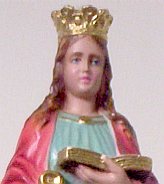Nelly, Our Garden Friend
 We don't really remember how the black and yellow argiope orb weaver came to be called "Nellie." The Baron thinks it was my son, Joe, who named her when he was a teenager and discovered one in the garden. He used to give her grasshoppers for dinner...perhaps the downside of raising a child without a television.
We don't really remember how the black and yellow argiope orb weaver came to be called "Nellie." The Baron thinks it was my son, Joe, who named her when he was a teenager and discovered one in the garden. He used to give her grasshoppers for dinner...perhaps the downside of raising a child without a television.There is a certain beauty -- distant, thank you -- of this voracious eater of insects. I am always glad to see her arrive and set up shop. In particular, the zipper she uses to sew everything together is most fascinating.
Today I bumped into this one on the north side of the house where the rhodendrons grow. Something has been chewing the leaves at an even greater rate this year so I was happy to have her in residence. I did speak to her about a more muscular work ethic, since it appears that she is quite capable of attracting and trapping rather large prey:
The Golden Orb Weavers build large, semi-permanent orb webs. The strong silk has a golden sheen. These spiders remain in their webs day and night and gain some protection from bird attack by the presence of a 'barrier network' of threads on one or both sides of the orb web. Sometimes their strong webs manage to trap small birds or bats, and the spider will wrap them and feed upon them. Commoner prey items include flies, beetles, locusts, wood moths and cicadas.
Somehow it is comforting to know she is not merely a season's entertainment. Orb spiders often live for twelve months or more:
The female Garden Orb Weaver lays her eggs in late summer to autumn. The eggs are encased in a fluffy silken cocoon and attached to foliage. The lifespan is about twelve months. They mature in summer, mate, lay their eggs, and die in late summer-autumn. Males and females are similar in size. During autumn, the spiderlings disperse by ballooning (floating on the breeze using small silk strands as "balloons"), and build their own tiny orb webs among vegetation.
How does she mate? I'm glad you asked. There doesn't appear to be any of that unladylike biting-the-heads-off-of-husbands that plague the behavior of lesser spiders:
In the Golden Orb Weaver group, it is common for a number of tiny (6 mm) males to live around the edges of a female's web, waiting for a mating opportunity. After mating, the female Golden Orb Weaver wraps her single egg sac in a mass of golden silk, which is then hidden on foliage away from the web, disguised within a curled leaf or sprig of twigs.
It all sounds rather well-organized and cozy. Meanwhile, I hope Nellie will polish off whatever it is that is feasting on my rhododenrons. Otherwise I shall have to make a mixture of chewing tobacco and cayenne sludge and coat the leaves -- especially next year's blossoms.
Death by Nellie would be nicer.


5 Comments:
Here's hoping that your insect-eater thrives. I used to see the weaver when I was a child--but not so much now. The webs are beautiful.
Perhaps you live in a more suburban environment than you did then. There is much more buy spray used there than in the country..
Good point! I don't use bug spray, but others around me do. Also, the county here sprays for gypsy moths.
Never named the critters, myself. Still, it's nice to know about others who appreciate our garden symbiots.
I'm allergic to most insect stings, but never seem to get them from the garden. Guess we all just respect and allow one another work space.
pb, you're just who we need! The Baron has been stung seven times this season while mowing the lawn. He's bombed six of the yellow jacket nests but couldn't find the last one. It's lurking out there somewhere, waiting for him.
Post a Comment
<< Home